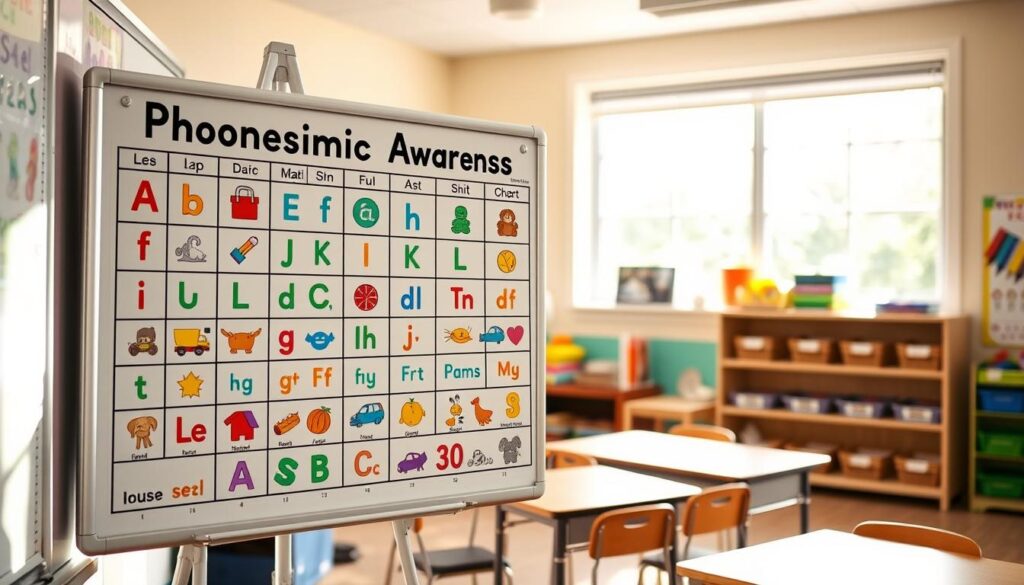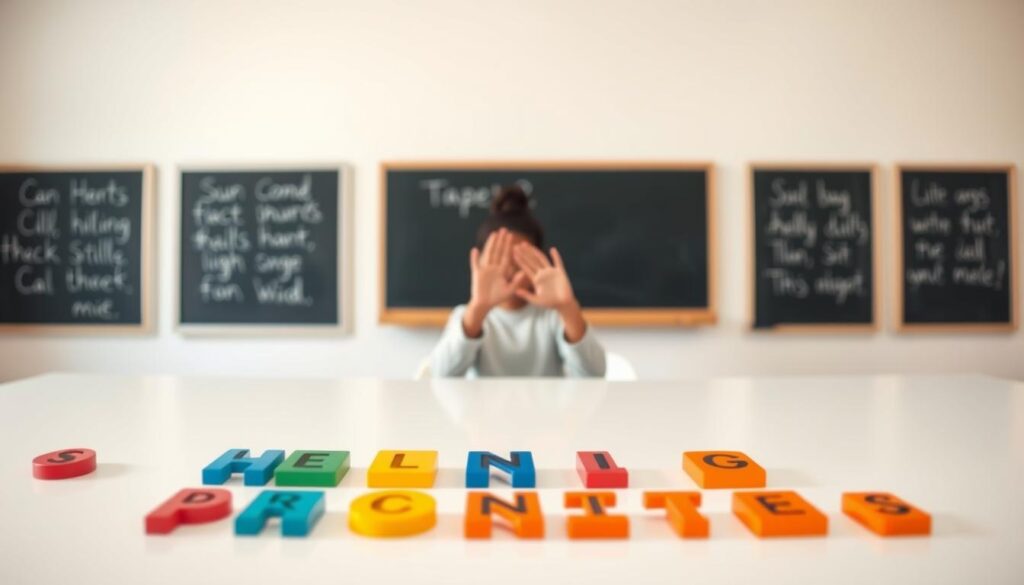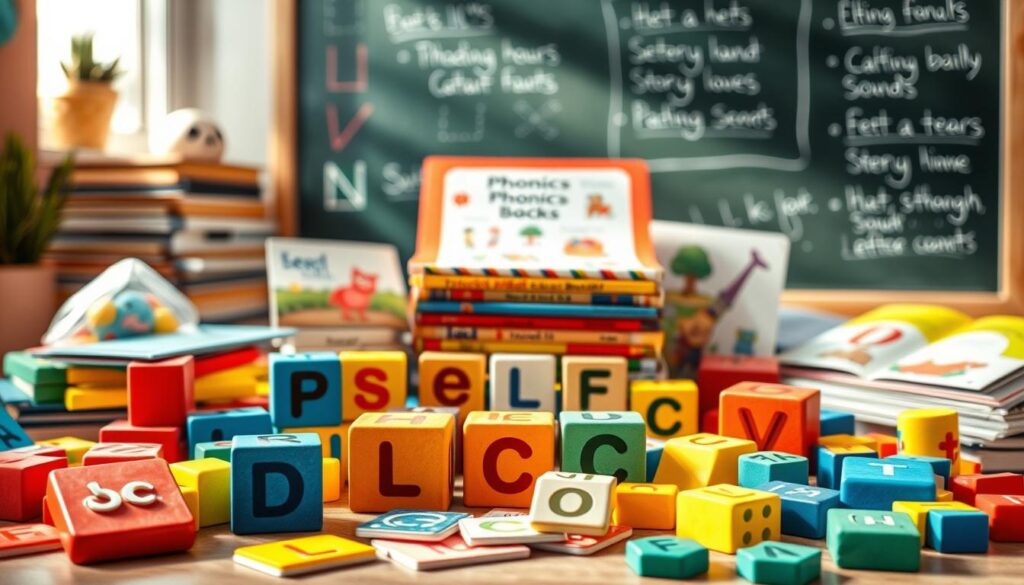How to Teach Letter Sounds
“The greatest sign of success for a teacher is to help students work as if they didn’t need you.” – Maria Montessori’s words capture the heart of early literacy. When young learners grasp how symbols connect to spoken language, they unlock the magic of reading independently.
Mastering these foundational skills transforms how children interact with text. It’s not just about memorizing symbols—it’s about building bridges between visual cues and spoken words. This connection lets kids decode everything from storybooks to street signs.
Effective instruction blends structure with creativity. Multi-sensory activities, like tracing shapes while saying their corresponding noises, make lessons stick. Consistency matters, but so does keeping young minds engaged through play and discovery.
Key Takeaways
- Early literacy success starts with linking symbols to spoken words
- Decoding skills boost confidence in new readers
- Structured yet flexible methods yield the best results
- Parental involvement accelerates learning progress
- Research confirms this foundation predicts reading achievement
The Role of Letter Sounds in Literacy

Every child’s reading journey starts with cracking the sound-symbol puzzle. Our language uses 44 distinct vocal patterns (phonemes) that combine like building blocks to form words. Recognizing how these units match written symbols turns abstract marks into meaningful communication.
Understanding Phonemic Awareness
This skill lets young learners play with language like clay. Kids who can isolate the /c/ in “cat” or blend /sh/ + /ip/ into “ship” gain power over written words. Research shows these auditory abilities predict reading success better than IQ scores in early grades.
The Importance of Letter-Sound Correspondence
Once ears recognize sounds, eyes learn their visual partners. Phonics instruction bridges this gap—/b/ isn’t just a noise, it’s the curve of b on paper. This knowledge transforms guessing into strategy: 78% of kindergarteners with strong sound-symbol skills read above grade level by third grade.
Vowels act as word anchors, while consonants shape meaning. A child who masters both can decode any word systematically—no memorization required. It’s literacy’s master key, forged through playful practice and patient guidance.
Effective Strategies for Teaching Letter Sounds
Building literacy superpowers begins with two game-changing approaches: prioritizing phonetic elements over alphabet labels and following a research-backed roadmap. These methods create confident decoders who see written language as solvable puzzles rather than mysterious symbols.
Introducing Sounds Before Alphabet Labels
Imagine a child excitedly shouting “/b/!/a/!/t/!” instead of spelling out letter names. That’s the power of sound-first instruction. When learners associate symbols with their verbal noises first, they bypass the mental hurdle of translating labels like “bee” into /b/ when reading.
This approach mirrors how speech develops naturally. Just as toddlers learn animal noises before species names, beginning readers grasp that squiggles on paper represent mouth movements. Studies show this method reduces early reading errors by 62% compared to traditional name-focused lessons.
Using Sequential Instruction for Maximum Retention
The magic happens when we introduce symbols in this order: a, m, t, p, o, n, c, d, u, s, g, h, i, f, b, l, e, r, w, k, x, v, y, z, j, q. Why this specific sequence?
- High-frequency characters appear first
- Visually distinct shapes prevent mix-ups
- Early word-building opportunities (at, mat, sat)
Separating look-alike symbols like b and d gives time to solidify each sound connection. This careful progression turns shaky attempts into fluent reading, like training wheels that gradually come off as skills strengthen.
Step-by-Step Instructional Procedures

Successful phonics lessons follow a clear path from demonstration to mastery. This structured approach helps young learners build confidence through gradual skill development. Let’s explore the three-phase method that turns hesitant attempts into fluent recognition.
Modeling and Guided Practice
Great teaching starts with crystal-clear examples. Teachers show the symbol while making its noise—like holding up m and stretching the “/mmmm/” vibration. This pure sound demonstration prevents confusion from letter names like “em.”
Next comes teamwork. Educators might point to the symbol and ask, “What’s our new friend say?” If a child hesitates, gentle reminders like “Lips together, hum it out” guide them. This supportive phase lets students practice with training wheels before riding solo.
Independent Practice and Feedback
Now it’s showtime! Children might sort symbols by their noises or play matching games. One first grader grinned as she shouted “/s/!” while slapping a card—her teacher high-fived the correct choice. Immediate responses cement connections.
Mistakes become teachable moments. If a learner picks d for “/b/”, instructors might mirror both sounds dramatically. This playful correction helps ears notice differences. Regular routines make these sessions feel like exciting challenges rather than tests.
Through this progression—demonstrate, collaborate, conquer—children gain skills that stick. The magic happens when a student suddenly beams: “I read it myself!” That’s the sound of literacy taking root.
Utilizing Supportive Materials and Resources

The right tools turn phonics practice into playtime magic. Hands-on materials and tech resources create bridges between abstract concepts and tangible understanding. Let’s explore three powerhouse categories that make learning stick.
Letter Cards, Alphabet Boards, and Adapted Keyboards
Cardstock heroes like a and m become building blocks in small hands. Kids sort them by shape or match them to objects starting with their noises. Alphabet boards take this further—they let children see how symbols team up to form words like cat or sun.
Tech tools add modern flair. Keyboards showing lowercase characters help young typists connect finger taps to language. One teacher shared: “My students light up when they type d and hear the /d/ sound—it clicks!”
Digital Tools and Interactive Activities
Tablet games turn drills into adventures. Apps might ask kids to pop bubbles with the /b/ symbol or feed a monster letters that make specific noises. These activities boost engagement while tracking progress behind the scenes.
Interactive whiteboards take collaboration further. Groups can drag symbols to build words, with instant audio feedback celebrating correct matches. It’s learning disguised as play.
Choosing Consistent Fonts and Visuals
Start simple. Early materials should use clear, uniform letter shapes—no fancy a with a curl. This prevents confusion when distinguishing similar symbols like n and h.
Once basics are mastered, introduce font variations. Show how book a differs from computer a. This flexibility prepares kids for real-world reading where symbols wear different outfits.
Quality resources adapt to diverse needs. Tactile cards help kinesthetic learners, while colorful digital boards captivate visual thinkers. When tools match how children explore, phonics becomes second nature.
Overcoming Common Challenges in Phonics Instruction
Navigating phonics challenges requires creative problem-solving and adaptable strategies. Educators often face twin hurdles: supporting diverse learning needs while preventing common mix-ups between visual symbols. The solution lies in tailored approaches that turn obstacles into growth opportunities.
Customizing Approaches for Diverse Learners
Krista’s story proves no challenge is insurmountable. Despite hearing, vision, and mobility differences, this 8-year-old mastered /m/ and /b/ using three key tools: sign language approximations, speech-output computers, and dual sensory input. Her progress after three weeks shows what’s possible when instruction matches individual needs.
Multi-sensory methods work wonders. Combining visual symbols with tactile activities helps learners who struggle with traditional approaches. For students with processing differences, tools like textured cards or voice-assisted apps make abstract concepts tangible.
Simplifying Complex Symbol Relationships
Some characters are trickier than others. The b/d puzzle trips up many beginners, which is why smart teaching sequences keep them apart. Introducing short vowels first (a vs. ā) builds confidence through consistent patterns.
Teachers use clever tricks to cement these distinctions:
- Color-coding similar symbols
- Practicing with rhyming word families
- Using physical gestures for each sound
Regular check-ins spot confusion early. When a child struggles, educators might switch fonts or add auditory cues. This proactive approach keeps small stumbles from becoming roadblocks.
Conclusion
Unlocking reading potential begins with systematic phonics instruction. When children grasp these connections between symbols and speech, they gain tools to decode unfamiliar words confidently. Our language’s 44 vocal building blocks form endless combinations—a code best cracked through structured yet engaging methods.
Parents and educators hold the key. Using the three-phase model—demonstrate, practice, apply—creates lasting results. Research shows consistent routines with playful materials accelerate progress. Those squiggles on pages transform into meaningful patterns when taught in logical sequences.
Remember: English vowels and consonants rarely follow single rules. This complexity makes early mastery vital. A child who understands multiple symbol relationships becomes a resilient reader, ready to explore chapter books or cereal boxes with equal enthusiasm.
The journey from recognizing alphabet shapes to reading fluently reshapes young minds. With patience and proven strategies, every learner can build this critical foundation. Watch their eyes light up when “cat” becomes more than letters—it becomes a story waiting to unfold.
FAQ
Why should I teach sounds before letter names?
How do I prevent confusion between similar letters like b and d?
What tools work best for teaching phonics?
How can I make phonics instruction accessible for all learners?
Should I correct mistakes during independent practice?
Why is sequential instruction important?
How do digital tools enhance phonics learning?

Sharon Molly is a content creator in lifestyle, fashion, and travel, delivering style-savvy advice and destination insights to inspire confident living. With a background in digital media, she combines aesthetics with practical guidance for modern women on the go.




